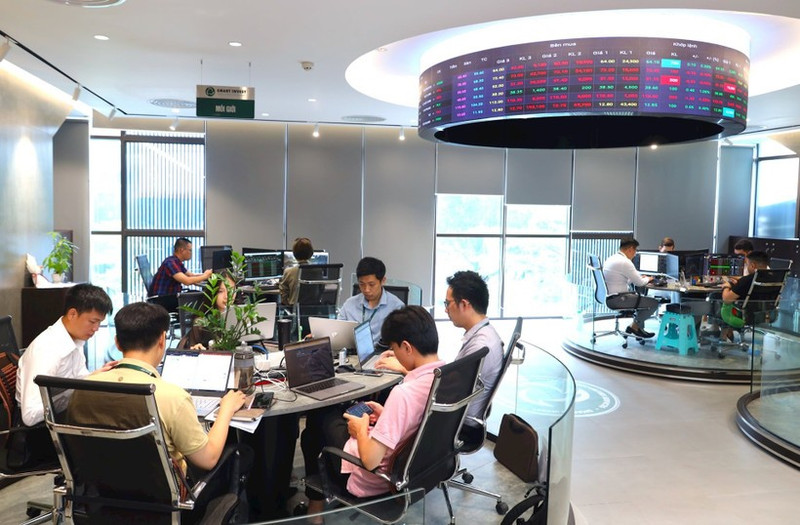A turning point for Viet Nam’s capital market
Viet Nam’s capital flows are at a crucial crossroads, marked by efforts to achieve emerging market status, attract both domestic and foreign investment, and stimulate business activity and overall economic growth.

Recent unexpected growth and high levels of activity in the stock market are fuelling optimism for a new era of development.
A major shift in capital flows
From its humble beginnings 25 years ago, when just two stocks were traded in relatively sluggish sessions, the Vietnamese stock market has evolved into a vibrant arena for capital mobilisation, attracting strong public interest.
As of the end of June 2025, the market boasted more than 1,600 securities, including over 700 stocks and fund certificates listed on the HOSE and HNX, and nearly 900 stocks trading on UPCoM. Dozens of companies now have market capitalisations in the billions of US dollars, with several surpassing the 10 billion USD mark.
Notably, stock market investment has increasingly overcome both psychological and legal barriers to become a popular wealth accumulation channel. The number of investor accounts has soared from 3,000 in 2000 to more than 10 million today, highlighting widespread public engagement with the country's burgeoning financial market. In the first six months of 2025 alone, an average of more than 17,000 new accounts were opened daily.
Marking its 25th anniversary, the market has seen record-breaking, ranking among the highest in ASEAN. Average daily matched order values on the HOSE have exceeded 35 trillion VND.
Analysts attribute this momentum to the influx of new capital, as investors increasingly recognise the broad opportunities offered by Vietnam’s dynamic and promising market.
Paving the way for a promising market
According to market participants, the current investment cycle is being supported by a distinct advantage: a streamlined, cohesive and resolute political system committed to fostering robust economic growth.
Analysts at Dragon Capital observe that the rapid market developments reflect the state’s ambitious vision. If these changes are successfully realised, the capital market could well be on the brink of a transformative era.
Le Anh Tuan, Investment Director at Dragon Capital, noted that from 2007 to 2025, Viet Nam focused on attracting foreign direct investment (FDI), encouraging multinational corporations to set up operations, shifting labour into higher productivity sectors, and enhancing capital accumulation. However, from 2025 onwards, the momentum has become increasingly endogenous. Inter-industry linkages have emerged, and national competitive advantages are being formed. The urgent, and natural, task now is to enhance the competitiveness of domestic enterprises. This is not merely a strategic adjustment but a critical factor for the country’s long-term development.
The recently passed Resolution No. 206/2025/QH15 allows the Government to address legal and procedural obstacles that the National Assembly has not yet had time to resolve through formal legislative amendments. This “special mechanism”, effective until February 28, 2027, differs from existing lawmaking processes and is expected to remove many existing bottlenecks. As Dang Nguyet Minh, Head of Research at Dragon Capital, pointed out, around 2,200 investment projects worth a total of 235 billion USD, equivalent to 50% of Viet Nam’s GDP, are currently stalled. If these projects are unblocked, they could unleash significant resources for the economy.
Another longstanding issue, the market upgrade has been discussed for over a decade, discouraging some foreign investors. However, this goal has now become a coordinated national strategy, focusing on three key areas: institutional reform, infrastructure improvement, and proactive engagement with global financial institutions.
This anticipated upgrade could be a catalyst for a wave of IPOs in 2026–2027, with listing values estimated to reach 47.5 billion USD over the next three years. The consumer sector alone is expected to contribute around 12.8 billion USD, with major names such as Thaco Auto, Bach Hoa Xanh and Golden Gate leading the way.
As noted by Vu Thi Chan Phuong, Chairwoman of the State Securities Commission, Viet Nam’s stock market has grown significantly in terms of both quality and product scale, becoming a key long-term funding channel. Attracting foreign portfolio investment, especially from institutional investors and major funds, could deliver wide-ranging benefits and further reinforce this capital channel.
However, Phuong also stressed that upgrading the market is not an end in itself but part of a longer journey to build and sustain investor confidence, both domestic and foreign, as well as trust from businesses and regulators.
As of July 23, 2025, the VN-Index had reached 1,523 points - its highest level in three years. The Vietnamese stock market has outperformed many others in the region, with the market capitalisation of listed stocks exceeding 8 quadrillion VND. The number of investor accounts has already surpassed the 9 million target set for 2025 in the national capital market development strategy to 2030.








